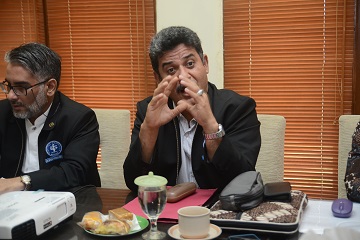IPB’s Professor: Ironically Indonesian Farmers Has to Work Double His Physical Ability for UMR Equivalent Income

Based on a research conduct by Professor of Faculty of Agricultural Technology, Bogor Agricultural University (IPB), Prof. Dr. Ir. M. Faiz Syuaib, M.Agr, it has been revealed that to earn wage equal to Regional Minimum Wage (UMR), farmers must double their physical capacity or power. This is explained in his inaugural oration as Professors of Faculty of Agricultural Technology at Dramaga Campus Bogor Agricultural University (5/5).
“We assumed a farmer has to work as long as worker in industrial sector to earn an income equal to UMR standard. So if yield per hectare reached five tones and dried grain price is 5000 rupiah, for each hectare, farmer has to work fulltime. Whereas in perspective of ergonomic work capacity, the average capacity of farmer manpower is equal to two men per hectare. It means that farmer need to work double their physical capacity to earn an income equal to UMR standard,” he explained.
From 191 millions hectares of land in Indonesia, only 8 millions hectares area for rice field and other 30 millions hectares area that are categorized for cropping area. Agriculture employs at least one third of workforce and become the livelihood of 40 millions households. Ironically, agricultural sector only contributed 11 percent of Gross Domestic Product (GDP). About 15 millions farmer households are small farmers, or in other words poor with no asset.
“Even though our unhulled rice production is already doubled (400 percent) the production during 70’s, but our average farmer exchange rate is stuck on 1.1. It means that people productivity and agricultural system are low. It is less competitive that other sectors, although the amount of time, effort and even financial investment are highly given to agricultural sector,” he conveyed.
According to Prof. Faiz, this happened because we pay less attention to the gap between the need of society and the eagerness or the policy of transferring process, implementation and priority of technology development. There is also a gap in the characteristic of implemented technology and a gap between economic factors and business scale compatibility or farmer’s land area to the adopted technology.
Government always makes the high population in Indonesia as a deadweight that their food needs must be guaranteed, when this high population can be seen as prosumer potency (producer as well as consumer) that can be empowered. With total area covering 6.7 percent of total land area of Indonesia, Java is inhabited by 57 percent of Indonesian population. Meanwhile, Kalimantan is inhabited by only 6 percent of Indonesian population and Papua is inhabited by only 1.5 percent of Indonesian population.
“I think number of population is not the issue, but the equity of population distribution. Java is so overpopulated. Population density in Java is 9 times higher than national average, there are 135 people per kilometer square. Let’s compare to Papua with only 10 people per kilometer square,” he explained.
For that, let's straighten our perspective of agriculture. Our agriculture is not efficient and has low productivity, which means that the income is also low.
Therefore, it requires human factor engineering to fix this condition. One of the approaches is anthropometric consideration (human’s body dimension) in designing tools or machines that will improve efficiency and performance. Result of anthropometric study, Indonesian people has similar body dimensions and characteristic with Indian people, but tend to be smaller that other Easterners such as Philippines, Chinese and Japanese.
Another example is the man power capacity, the metabolic ability that allocated by a person to perform an activity in producing one product in certain time duration.
“Our research's result, from perspective of ergonomic work capacity, calculated that rice cultivation system of terraced mountain area in Bogor Region averagely required 2 men per hectare. In other words, man power capacity is 0.5 hectare per person,” he said. (Zul)



